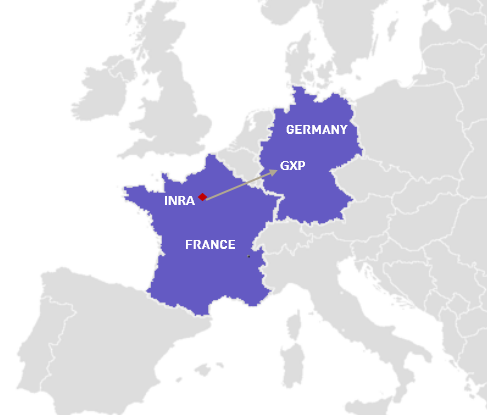PRESENTATION OF THE SUB-PROJECT 9
Transcription regulatory network construction
HOST INSTITUTION AND SUPERVISORS:
INRA MaIAGE, DR. Pierre NICOLAS, DR. Vincent FROMION and DR. Sophie SCHBATH (more details)
OBJECTIVES:
A significant part of regulation at the transcriptional level is achieved by modulation of transcription initiation rate. In bacteria, transcription initiation relies on recognition of particular sequence motif by a Sigma-factor approximately 10 bp upstream of the transcription start site (TSS). Tiling array and next generation sequencing transcriptomics provide direct information on the repertoire of TSSs and transcription units and thereby offer new perspectives to address the problem of motif identification. As a first step, we will characterise the transcriptional activity of the bacteria (detection of trancripts, delineation of operon structure, identifications of TSS and transcription terminators) by using existing tools. As a second step, we will develop new methods for prediction of TF binding sites by combining expression profiles and precise information on the location of the TSSs. Two approaches based on position weight matrix (PWM) models would be investigated. We will extend the classical mixture model by relaxing the hypothesis that motifs corresponding to different TF binding sites occur independently between TSS regions. In the new model, we will explicitly account for the increased probability of occurrence of a same motif in two promoters when their profiles of activity across conditions are similar. In parallel, we could use Hawkes’ processes to screen a list of candidate motifs. Hawkes’ processes allow the analysis of the patterns of motif co-occurrence at preferential distances and will also serve here to account for expression patterns.
EXPECTED RESULTS:
Construction of a mathematical model of the regulatory network of L. monocytogenes. First of all, existing data will be integrated in a first model of regulatory network. In a second step, experimental data will be processed to generate the final model. Elucidation of the effect of environmental conditions on virulon expression.
SECONDMENTS:
GenXPRO (more details)
DURATION OF THE RECRUITMENT :
36 months
PRESENTATION OF THE FELLOW
Ibrahim SULTAN
MY PREVIOUS TRAINING AND EXPERIENCE:
I come from Egypt where I made a B.Sc. in Electrical Communications and Electronic Systems in MSA University in Cairo, after I started a Joint Master degree (Erasmus Mundus Master program) in Mathematical Engineering between University of L’Aquila in Italy and Hamburg University in Germany. Currently I am an Early stage researcher (PhD Fellow) since 2015 and I am based in Paris, France where I am working on mathematical modelling in life science.
WHY I WANTED TO JOIN THE PROJECT :
Currently, my plans for the future are more academically oriented than industry oriented. My motivation to do this PhD project stems from my deep interest for the research area of applied mathematics in biology. With this project I wish to continue exploring this field and finally to be able to add something new and innovative. INRA MaIAGE is a leading lab in the area of mathematical biology specially informatics and system biology where I am interested to continue my research.
ABOUT MY RESEARCH PROJECT :
A central objective of the List_Maps project is to decipher the mechanisms underlying adaption and virulence of L. monocytogenes “from farm to fork”. This PhD project aims to tackle the task of transcription regulatory network construction. In this project we intend to assess existing tools and to develop new methods for prediction of TF binding sites by combining expression profiles and precise information on the location of the TSSs. Several approaches based on position weight matrix (PWM) models will be investigated to extend the classical mixture model by relaxing the hypothesis that motifs corresponding to different TF binding sites occur independently between TSS regions. In the new model, we will explicitly account for the increased probability of occurrence of a same motif in two promoters when their profiles of activity across conditions are similar. A particular attention will also be paid to the position of the motif with respect to the TSS and the sigma factor binding site. Besides this methodological developments we will also work on the use of these approaches to build the transcription regulatory network of L. monocytogenes based on data from the literature and from the List_MAPS project. Finally, we wish to use the information on the regulatory network to tackle a particular point relevant for the List_MAPS project (such as prediction of virulence from genome or transcriptome data) using a dedicated model.
OTHERS INTERESTS:
Voluntary work (Literacy- children- social services).
Sports (Running- tennis- chess).
CONTACT :
![]() This project has received funding from the European Union’s Horizon 2020 research and innovation programme under the Marie Sklodowska Curie grant agreement n° 641984
This project has received funding from the European Union’s Horizon 2020 research and innovation programme under the Marie Sklodowska Curie grant agreement n° 641984


